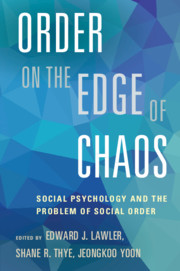Book contents
- Frontmatter
- Contents
- List of Contributors
- Preface
- 1 Social Psychology of Social Order: An Introduction
- 2 The Evolutionary Biology and Sociology of Social Order
- 3 Social Rationality and Weak Solidarity: A Coevolutionary Approach to Social Order
- 4 An Integrative Theory of Action: The Model of Frame Selection
- 5 The Center Cannot Hold: Networks, Echo Chambers, and Polarization
- 6 Social Exchange and Social Order: An Affect Theory Approach
- 7 Institutions, Trust, and Social Order
- 8 Identity Verifi cation and the Social Order
- 9 Identities, Roles, and Social Institutions: An Affect Control Account of Social Order
- 10 The Gender Frame and Social Order
- 11 Status, Power, and Social Order
- 12 Interaction Order: The Making of Social Facts
- 13 The Arts of Together: Social Coordination as Dyadic Achievement
- 14 Dignity as Moral Motivation: The Problem of Social Order Writ Small
- 15 The Legitimacy of Groups and the Mobilization of Resources
- Commentary: Contrasts and Complementarities
- Index
- References
9 - Identities, Roles, and Social Institutions: An Affect Control Account of Social Order
Published online by Cambridge University Press: 05 December 2015
- Frontmatter
- Contents
- List of Contributors
- Preface
- 1 Social Psychology of Social Order: An Introduction
- 2 The Evolutionary Biology and Sociology of Social Order
- 3 Social Rationality and Weak Solidarity: A Coevolutionary Approach to Social Order
- 4 An Integrative Theory of Action: The Model of Frame Selection
- 5 The Center Cannot Hold: Networks, Echo Chambers, and Polarization
- 6 Social Exchange and Social Order: An Affect Theory Approach
- 7 Institutions, Trust, and Social Order
- 8 Identity Verifi cation and the Social Order
- 9 Identities, Roles, and Social Institutions: An Affect Control Account of Social Order
- 10 The Gender Frame and Social Order
- 11 Status, Power, and Social Order
- 12 Interaction Order: The Making of Social Facts
- 13 The Arts of Together: Social Coordination as Dyadic Achievement
- 14 Dignity as Moral Motivation: The Problem of Social Order Writ Small
- 15 The Legitimacy of Groups and the Mobilization of Resources
- Commentary: Contrasts and Complementarities
- Index
- References
Summary
Abstract
We locate the micro-foundations of social order in the cultural meanings of institutional identities and roles, the daily enactment of which ensures social order through the continual reproduction and legitimation of social institutions. Following discussion of a general conceptual model, we discuss two complementary, micro-level explanations of social order: a cognitive approach combining a classic micro-sociological theory of institutions with a recent method for analyzing the causal structures of social actions in institutional settings; and an affective approach based on affect control theory. We then present two analyses illustrating specific sectors of our conceptual model. The first deals with cognitive meanings, showing how social institutions are present as associative structures within individuals’ minds, enabling them to define situations in institutional contexts. The second demonstrates how the evaluation, potency, and activity dimensions of affective meaning employed by affect control theory correspond to the structure of interdependence relations as represented in game matrices.
In the augmented symbolic interactionist perspective that we present here, human activities are stimulated and maintained by cognitive and affective meanings, and change emerges as new human activities evolve or are consciously designed in ways that instigate new meanings. This symbolic interactionism is “augmented” in that it incorporates affective meanings along with cognitive meanings, and it allows for multiple kinds of human activities, from various kinds of thought to individual behavior to coordinated group actions.
In this framework, cognitive experiences of successive generations accumulate as practical knowledge (Berger and Luckmann 1966), while emotional experiences accumulate as cultural sentiments (Heise 2007; MacKinnon and Heise 2010). Through socialization, individuals internalize both kinds of cultural meaning; and by employing practical knowledge and cultural sentiments to guide and motivate their interpersonal activities, they ensure the continual reproduction of the organized activities that embody society.
Social order is the outcome of complex, reciprocal relations among cultural and social processes at different levels of analysis, as portrayed in Figure 9.1, from MacKinnon and Heise's 2010 book. MacKinnon and Heise used this figure to explain the construction and interplay of selves and social institutions, but a lot of conceptual territory was left unanalyzed in their presentation. In this chapter, we employ Figure 9.1 as a theoretical scaffold for explaining selected aspects of social order.
- Type
- Chapter
- Information
- Order on the Edge of ChaosSocial Psychology and the Problem of Social Order, pp. 165 - 188Publisher: Cambridge University PressPrint publication year: 2015
References
- 21
- Cited by

